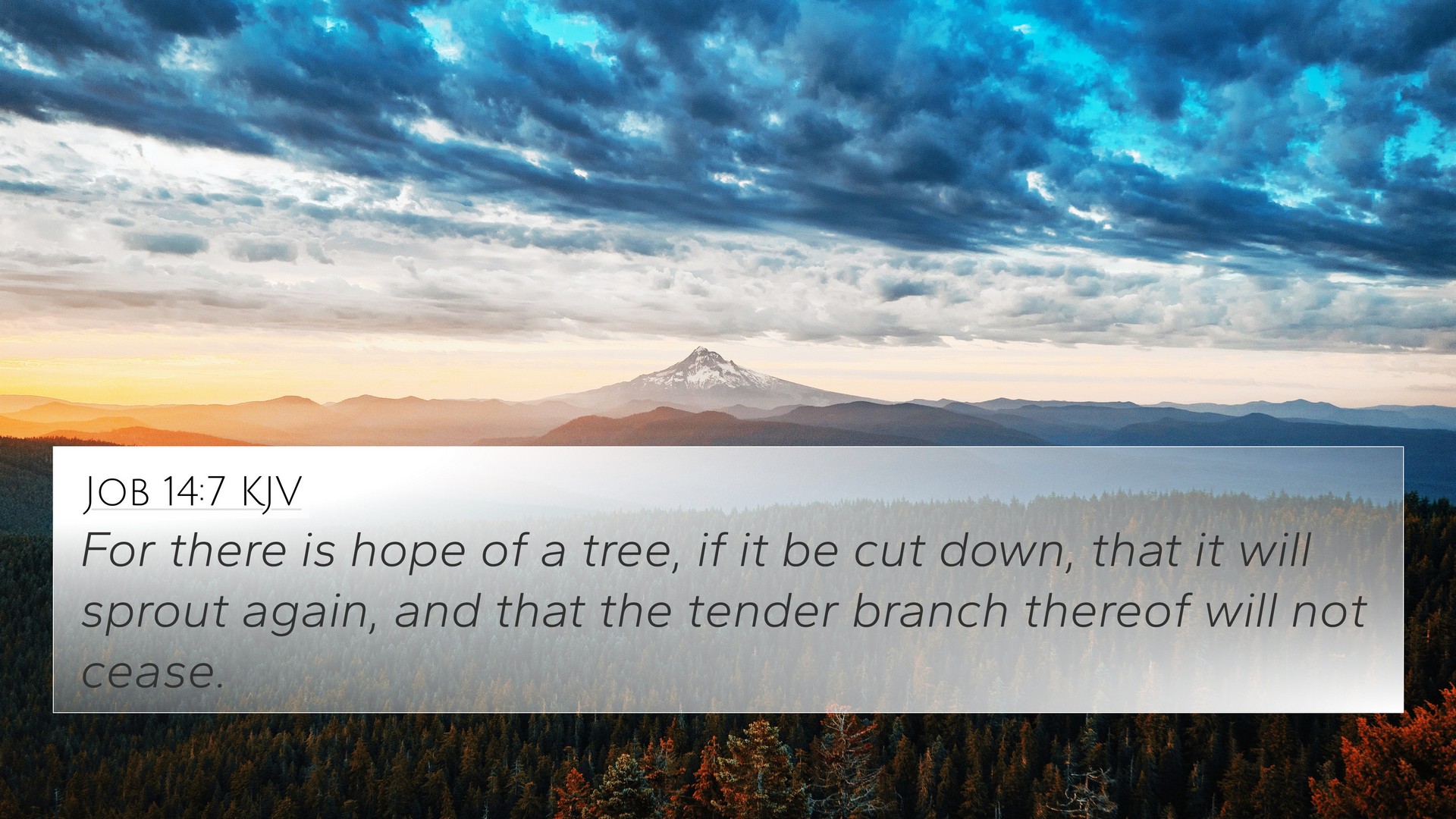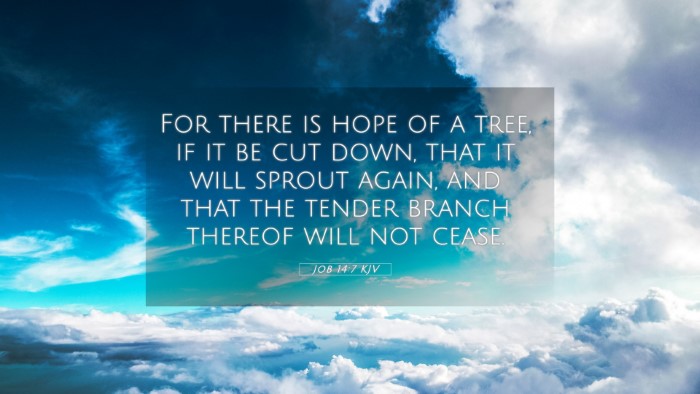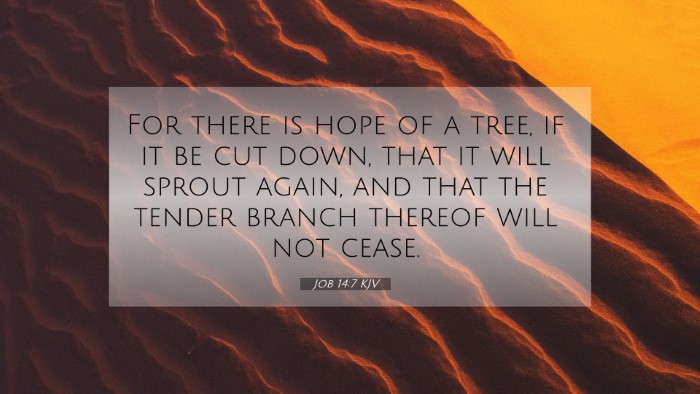Old Testament
Genesis Exodus Leviticus Numbers Deuteronomy Joshua Judges Ruth 1 Samuel 2 Samuel 1 Kings 2 Kings 1 Chronicles 2 Chronicles Ezra Nehemiah Esther Job Psalms Proverbs Ecclesiastes Song of Solomon Isaiah Jeremiah Lamentations Ezekiel Daniel Hosea Joel Amos Obadiah Jonah Micah Nahum Habakkuk Zephaniah Haggai Zechariah MalachiJob 14:7 Similar Verses
Job 14:7 Cross References
For there is hope of a tree, if it be cut down, that it will sprout again, and that the tender branch thereof will not cease.
Uncover the Rich Themes and Topics of This Bible Verse
Listed below are the Bible themes associated with Job 14:7. We invite you to explore each theme to gain deeper insights into the Scriptures.
Job 14:7 Cross Reference Verses
This section features a detailed cross-reference designed to enrich your understanding of the Scriptures. Below, you will find carefully selected verses that echo the themes and teachings related to Job 14:7 KJV. Click on any image to explore detailed analyses of related Bible verses and uncover deeper theological insights.
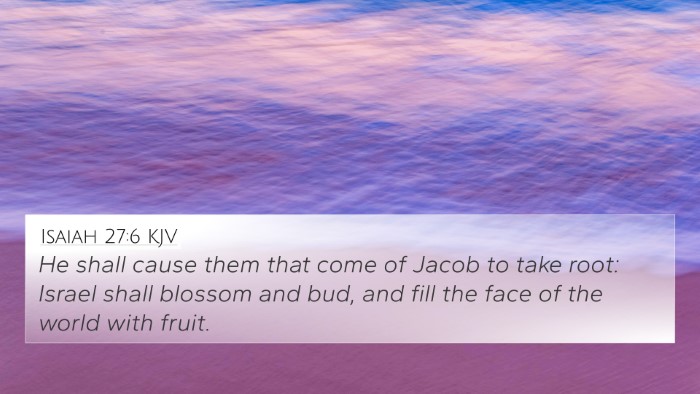
Isaiah 27:6 (KJV) »
He shall cause them that come of Jacob to take root: Israel shall blossom and bud, and fill the face of the world with fruit.
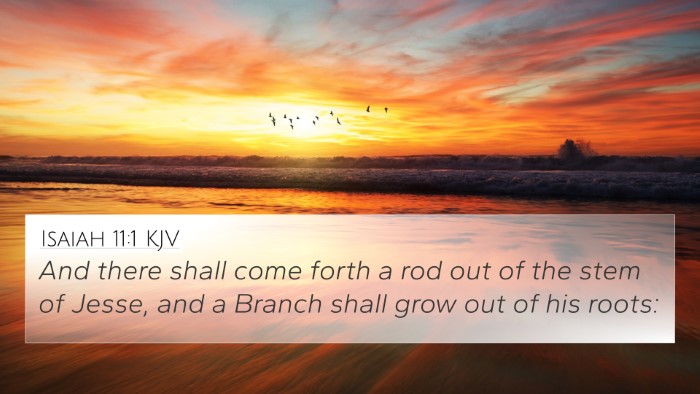
Isaiah 11:1 (KJV) »
And there shall come forth a rod out of the stem of Jesse, and a Branch shall grow out of his roots:

Job 14:14 (KJV) »
If a man die, shall he live again? all the days of my appointed time will I wait, till my change come.
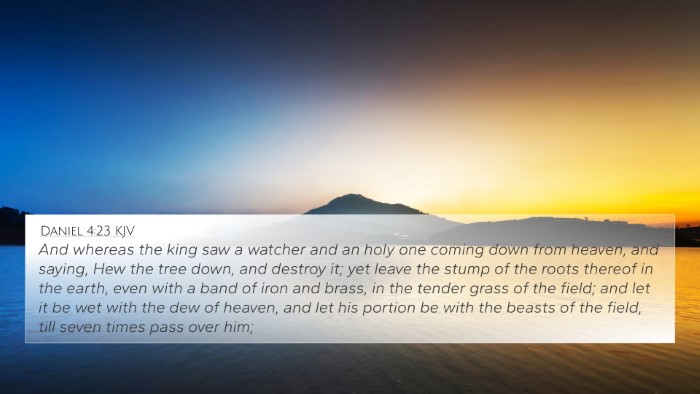
Daniel 4:23 (KJV) »
And whereas the king saw a watcher and an holy one coming down from heaven, and saying, Hew the tree down, and destroy it; yet leave the stump of the roots thereof in the earth, even with a band of iron and brass, in the tender grass of the field; and let it be wet with the dew of heaven, and let his portion be with the beasts of the field, till seven times pass over him;
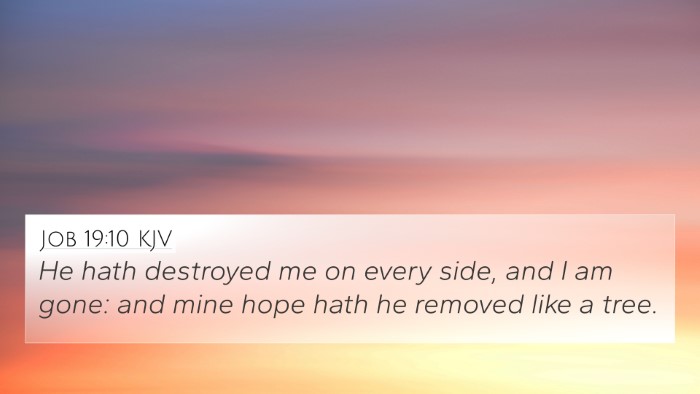
Job 19:10 (KJV) »
He hath destroyed me on every side, and I am gone: and mine hope hath he removed like a tree.
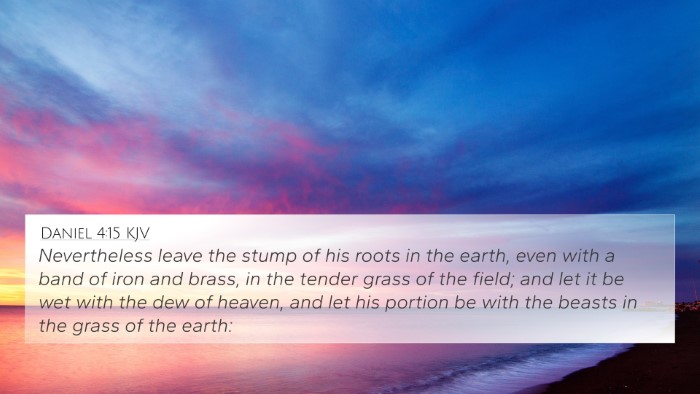
Daniel 4:15 (KJV) »
Nevertheless leave the stump of his roots in the earth, even with a band of iron and brass, in the tender grass of the field; and let it be wet with the dew of heaven, and let his portion be with the beasts in the grass of the earth:
Job 14:7 Verse Analysis and Similar Verses
Understanding Job 14:7
The verse Job 14:7 states, "For there is hope for a tree, if it be cut down, that it will sprout again, and that its tender branch will not cease." This verse encapsulates a profound message about hope and regeneration, not only in nature but in the human experience as well.
Summary of Meaning
Job's statement reflects his profound contemplation on life, death, and the potential for restoration. The tree symbolizes resilience, illustrating that even when faced with seemingly insurmountable odds, there remains hope for rejuvenation. This perspective can offer comfort in times of distress, suggesting that no situation is ever entirely hopeless.
Commentary Insights
Matthew Henry's Commentary
Matthew Henry emphasizes the symbolism of the tree. He notes that while a tree can endure devastation, it can still flourish again when nurtured. This serves as an analogy for human despair; even in grief and loss, there is the potential for new beginnings.
Albert Barnes' Notes
Albert Barnes adds that this verse demonstrates the principle of life and renewal. He points out that the hope expressed in this passage is a reminder of God's mercy in offering new opportunities, even after a fall. The cyclical nature of life encourages believers to maintain faith amidst trials.
Adam Clarke's Commentary
Adam Clarke interprets the hope mentioned in the verse as a lesson about faith. He highlights the expectation of a new life stemming from adversity. Clarke draws parallels with the Christian notion of resurrection, suggesting the potential for spiritual rebirth after struggle.
Connections to Other Bible Verses
Job 14:7 shares themes with several other Biblical passages, highlighting similar concepts of hope, renewal, and the cyclical nature of life:
- Psalms 30:5: "Weeping may endure for a night, but joy comes in the morning." This verse shows the temporary nature of sorrow and the promised revival of joy.
- Isaiah 40:31: "But those who wait on the Lord shall renew their strength; they shall mount up with wings like eagles." This reflects the theme of restoration through faith.
- Ezekiel 37:1-14: The valley of dry bones signifies revival and restoration, mirroring the message of hope in Job 14:7.
- 2 Corinthians 5:17: "Therefore, if anyone is in Christ, he is a new creation; the old has passed away." This New Testament perspective aligns with the hope of new beginnings post-trial.
- Romans 8:28: "And we know that in all things God works for the good of those who love him." This assurance supports the notion of eventual good arising from adversity.
- Matthew 19:26: "With God all things are possible." This reinforces the belief that even the most dire situations can lead to hope.
- Philippians 1:6: "He who began a good work in you will carry it on to completion." This verse emphasizes continuous growth and transformation, akin to the regrowth of the tree.
Thematic Bible Verse Connections
Exploring the connections among these verses can enrich one’s understanding of fundamental Biblical themes:
- Hope in Trials: The connection between Job's statement and passages such as Romans 5:3-5 illustrates the enduring hope amid suffering.
- God’s Faithfulness: Linking Isaiah 41:10 and Job 14:7 shows how God’s presence sustains believers through adversity.
- Renewal and Restoration: Verses like Ezekiel 36:26 discuss the promise of spiritual renewal, resonating with Job's metaphor of the tree.
Scriptural Cross-Referencing Tools
For deeper exploration of these connections, various tools for Bible cross-referencing can be beneficial:
- Bible concordance
- Bible cross-reference guide
- Bible reference resources
- Cross-reference Bible study methods
- Comprehensive Bible cross-reference materials
Conclusion
In Job 14:7, the symbolism of the tree offers profound insights into human hope and divine renewal. The connections between this verse and others establish a rich tapestry of understanding that encourages readers to search for hope amidst trials. By engaging with the themes and cross-references, one can unveil a deeper appreciation for the resilience inherent in both nature and faith.
